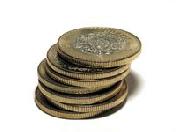
 |
|
| Financial Terms | |
| fixed assets |
|
Information about financial, finance, business, accounting, payroll, inventory, investment, money, inventory control, stock trading, financial advisor, tax advisor, credit.
Main Page: inventory, stock trading, accounting, credit, financial, payroll, business, inventory control, |
Definition of fixed assets
fixed assetsAn informal term that refers to the variety of long-term operating Fixed AssetsLand, buildings, plant, equipment, and other assets acquired for carrying on the business of a company with a life exceeding one year. Normally expressed in financial accounts at cost, less accumulated depreciation. Fixed assetsThings that the business owns and are part of the business infrastructure – fixed assets may be
Related Terms:Intangible fixed assetsNon-physical assets, e.g. customer goodwill or intellectual property (patents and trademarks). Tangible fixed assetsPhysical assets that can be seen and touched, e.g. buildings, machinery, vehicles, computers etc. Fixed Assets Turnover RatioA measure of the utilization of a company's fixed assets to Longer-Term Fixed Assetsassets having a useful life greater than one year but the duration of the 'long term' will vary with the context in which the term is applied. Cash flow from operationsA firm's net cash inflow resulting directly from its regular operations  Fixed assetLong-lived property owned by a firm that is used by a firm in the production of its income. Fixed asset turnover ratioThe ratio of sales to fixed assets. Margin callA demand for additional funds because of adverse price movement. Maintenance margin Monetary / non-monetary methodUnder this translation method, monetary items (e.g. cash, accounts Restrictive covenantsProvisions that place constraints on the operations of borrowers, such as restrictions on investing activitiesOne of the three classes of cash flows reported in the mark to marketRefers to the accounting method that records increases property, plant, and equipmentThis label is generally used in financial straight-line depreciationThis depreciation method allocates a uniform  Total Asset Turnover RatioA measure of the utilization of all of a company's assets to GoodwillThe excess of the price paid to buy another company over the book value of Other assetsA cluster of accounts that are listed after fixed assets on the balance sheet, Property, plant, and equipmentThis item is comprised of all types of fixed assets Change in Accounting EstimateA change in accounting that occurs as the result of new information Business Expansion InvestmentThe use of capital to create more money through the addition of fixed assets or through income producing vehicles. Capital InvestmentsMoney used to purchase fixed assets for a business, such as land, buildings, or machinery. Also, money invested in a business on the understanding that it will be used to purchase permanent assets rather than to cover day-to-day operating expenses. DepreciationAmortization of fixed assets, such as plant and equipment, so as to allocate the cost over their depreciable life. LeasingContract granting use of real estate, equipment, or other fixed assets for a specified time in exchange for payment, usually in the form of rent. The owner of the leased property is called the lessor, the user the lessee. Lease (Credit Insurance)Contract granting use of real estate, equipment or other fixed assets for a specified period of time in exchange for payment. The owner or a leased property is the lessor and the user the lessee. Acquisition of assetsA merger or consolidation in which an acquirer purchases the selling firm's assets. AssetsA firm's productive resources. Assets requirementsA common element of a financial plan that describes projected capital spending and the Current assetsValue of cash, accounts receivable, inventories, marketable securities and other assets that Exchange of assetsAcquisition of another company by purchase of its assets in exchange for cash or stock. Financial assetsClaims on real assets. Fixed costA cost that is fixed in total for a given period of time and for given production levels. Fixed-annuitiesAnnuity contracts in which the insurance company or issuing financial institution pays a Fixed-charge coverage ratioA measure of a firm's ability to meet its fixed-charge obligations: the ratio of Fixed-datesIn the Euromarket the standard periods for which Euros are traded (1 month out to a year out) are Fixed-dollar obligationsConventional bonds for which the coupon rate is set as a fixed percentage of the par value. Fixed-dollar securityA nonnegotiable debt security that can be redeemed at some fixed price or according to Fixed-exchange rateA country's decision to tie the value of its currency to another country's currency, gold Fixed-income equivalentAlso called a busted convertible, a convertible security that is trading like a straight Fixed-income instrumentsassets that pay a fixed-dollar amount, such as bonds and preferred stock. Fixed-income marketThe market for trading bonds and preferred stock. Fixed price basisAn offering of securities at a fixed price. Fixed-price tender offerA one-time offer to purchase a stated number of shares at a stated fixed price, Fixed-rate loanA loan on which the rate paid by the borrower is fixed for the life of the loan. Fixed-rate payerIn an interest rate swap the counterparty who pays a fixed rate, usually in exchange for a Long-term assetsValue of property, equipment and other capital assets minus the depreciation. This is an Net assetsThe difference between total assets on the one hand and current liabilities and noncapitalized longterm Non-reproducible assetsA tangible asset with unique physical properties, like a parcel of land, a mine, or a Other current assetsValue of non-cash assets, including prepaid expenses and accounts receivable, due Publicly traded assetsassets that can be traded in a public market, such as the stock market. Quick assetsCurrent assets minus inventories. Real assetsIdentifiable assets, such as buildings, equipment, patents, and trademarks, as distinguished from a Reproducible assetsA tangible asset with physical properties that can be reproduced, such as a building or Residual assetsassets that remain after sufficient assets are dedicated to meet all senior debtholder's claims in full. Return on assets (ROA)Indicator of profitability. Determined by dividing net income for the past 12 months Return on total assetsThe ratio of earnings available to common stockholders to total assets. ASSETSAnything of value that a company owns. Current assetsCash, things that will be converted into cash within a year (such as accounts receivable), and inventory. RATE OF RETURN ON TOTAL ASSETSThe percentage return or profit that management made on each dollar of assets. The formula is: AssetsThings that the business owns. Current assetsAmounts receivable by the business within a period of 12 months, including bank, debtors, inventory and prepayments. Fixed costsCosts that do not change with increases or decreases in the volume of goods or services Semi-fixed costs Costs that are constant within a defined level of activity but that can increase or decrease when AssetsItems owned by the company or expenses that have been paid for but have not been used up. Intangible assetsassets owned by the company that do not possess physical substance; they usually take the form of rights and privileges such as patents, copyrights, and franchises. current assetsCurrent refers to cash and those assets that will be turned fixed expenses (costs)Expenses or costs that remain the same in amount, return on assets (ROA)Although there is no single uniform practice for Fixed Charge Coverage RatioA measure of how well a company is able to meet its fixed Return on Total Assets RatioA measure of the percentage return earned on the value of the Total Debt to Total Assets RatioSee debt ratio fixed costa cost that remains constant in total within a specified fixed overhead spending variancethe difference between the total actual fixed overhead and budgeted fixed overhead; fixed overhead volume variancesee volume variance Fixed-income securityA security that pays a specified cash flow over a Fixed assetAn item with a longevity greater than one year, and which exceeds a company’s Fixed costA cost that does not vary in the short run, irrespective of changes in any Fixed overheadThat portion of total overhead costs which remains constant in size financial assetsClaims to the income generated by real assets. Also called securities. fixed costsCosts that do not depend on the level of output. real assetsassets used to produce goods and services. Fixed Exchange RateAn exchange rate held constant by a government promise to buy or sell dollars at the fixed rate on the foreign exchange market. Preferred Stock Stock that has a claim on assets and dividends of a corporation that are priorto that of common stock. Preferred stock typically does not carry the right to vote. Realizable Revenue A revenue transaction where assets received in exchange for goods andservices are readily convertible into known amounts of cash or claims to cash. Fixed-location storageAn inventory storage technique under which permanent Current AssetsCash and other company assets that can be readily turned into cash within one year. Fixed ExpensesCost of doing business which does not change with the volume of business. Examples might be rent for business premises, insurance payments, heat and light. Fixed Interest RateA rate that does not fluctuate with general market conditions. Fixed Rate LoanLoan for a fixed period of time with a fixed interest rate for the life of the loan. Personal Assetsassets, the title of which are held personally rather than in the name of some other legal entity. Cash-flow break-even pointThe point below which the firm will need either to obtain additional financing Pass-through securitiesA pool of fixed-income securities backed by a package of assets (i.e. mortgages) Preferred stockA security that shows ownership in a corporation and gives the holder a claim, prior to the Rate riskIn banking, the risk that profits may decline or losses occur because a rise in interest rates forces up depreciationRefers to the generally accepted accounting principle of allocating sunk costA cost that has been paid and cannot be undone or reversed. Capital StructureThe combination of debt, preferred stock, and common stock used Preferred StockA type of equity security where holders have a claim on the assets Related to : financial, finance, business, accounting, payroll, inventory, investment, money, inventory control, stock trading, financial advisor, tax advisor, credit. |